Coventry University 102MAE Mechanical Science Lab Report Analysis
VerifiedAdded on 2022/08/24
|20
|1764
|43
Report
AI Summary
This mechanical science lab report details three experiments conducted as part of a 102MAE module at Coventry University. The first experiment investigates frictional losses in pipes, analyzing the relationship between flow rate, friction factor, and Reynolds number. The second experiment focuses on pin-jointed frames, examining stress and strain under varying loads, and calculating safety factors. The third experiment explores flow measurement using a Venturi meter and orifice plate, comparing experimental flow rates with theoretical calculations. The report includes experimental setups, methodologies, results, sample calculations, discussions, and conclusions for each experiment, providing a comprehensive analysis of the principles of fluid mechanics and structural analysis. The report also highlights potential sources of error and the practical applications of the concepts studied.
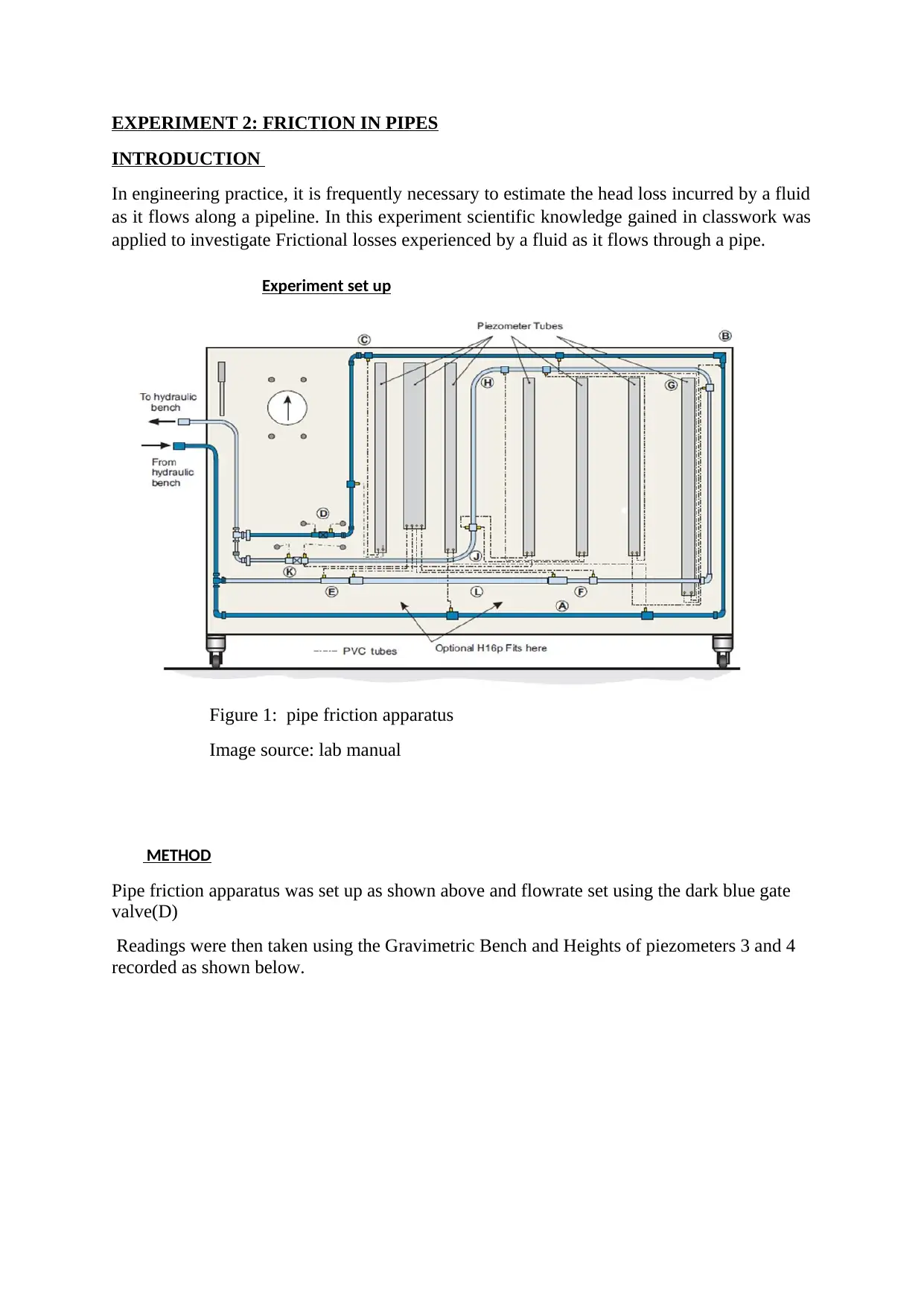
EXPERIMENT 2: FRICTION IN PIPES
INTRODUCTION
In engineering practice, it is frequently necessary to estimate the head loss incurred by a fluid
as it flows along a pipeline. In this experiment scientific knowledge gained in classwork was
applied to investigate Frictional losses experienced by a fluid as it flows through a pipe.
Experiment set up
Figure 1: pipe friction apparatus
Image source: lab manual
METHOD
Pipe friction apparatus was set up as shown above and flowrate set using the dark blue gate
valve(D)
Readings were then taken using the Gravimetric Bench and Heights of piezometers 3 and 4
recorded as shown below.
INTRODUCTION
In engineering practice, it is frequently necessary to estimate the head loss incurred by a fluid
as it flows along a pipeline. In this experiment scientific knowledge gained in classwork was
applied to investigate Frictional losses experienced by a fluid as it flows through a pipe.
Experiment set up
Figure 1: pipe friction apparatus
Image source: lab manual
METHOD
Pipe friction apparatus was set up as shown above and flowrate set using the dark blue gate
valve(D)
Readings were then taken using the Gravimetric Bench and Heights of piezometers 3 and 4
recorded as shown below.
Paraphrase This Document
Need a fresh take? Get an instant paraphrase of this document with our AI Paraphraser
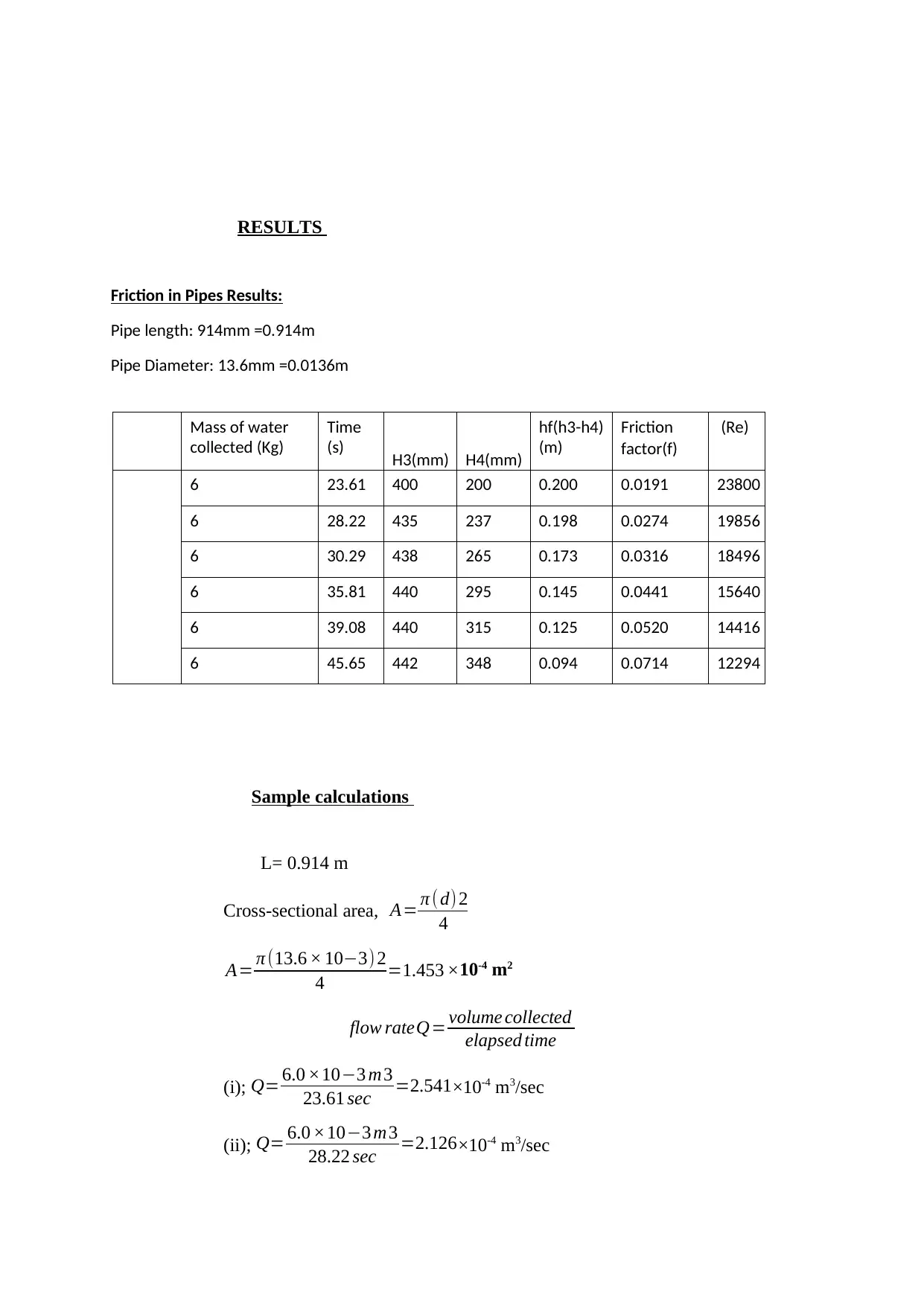
RESULTS
Friction in Pipes Results:
Pipe length: 914mm =0.914m
Pipe Diameter: 13.6mm =0.0136m
Mass of water
collected (Kg)
Time
(s) H3(mm) H4(mm)
hf(h3-h4)
(m)
Friction
factor(f)
(Re)
6 23.61 400 200 0.200 0.0191 23800
6 28.22 435 237 0.198 0.0274 19856
6 30.29 438 265 0.173 0.0316 18496
6 35.81 440 295 0.145 0.0441 15640
6 39.08 440 315 0.125 0.0520 14416
6 45.65 442 348 0.094 0.0714 12294
Sample calculations
L= 0.914 m
Cross-sectional area, A= π ( d) 2
4
A= π (13.6 × 10−3) 2
4 =1.453 ×10-4 m2
flow rateQ= volume collected
elapsed time
(i); Q= 6.0 ×10−3 m3
23.61 sec =2.541×10-4 m3/sec
(ii); Q= 6.0 ×10−3 m3
28.22 sec =2.126×10-4 m3/sec
Friction in Pipes Results:
Pipe length: 914mm =0.914m
Pipe Diameter: 13.6mm =0.0136m
Mass of water
collected (Kg)
Time
(s) H3(mm) H4(mm)
hf(h3-h4)
(m)
Friction
factor(f)
(Re)
6 23.61 400 200 0.200 0.0191 23800
6 28.22 435 237 0.198 0.0274 19856
6 30.29 438 265 0.173 0.0316 18496
6 35.81 440 295 0.145 0.0441 15640
6 39.08 440 315 0.125 0.0520 14416
6 45.65 442 348 0.094 0.0714 12294
Sample calculations
L= 0.914 m
Cross-sectional area, A= π ( d) 2
4
A= π (13.6 × 10−3) 2
4 =1.453 ×10-4 m2
flow rateQ= volume collected
elapsed time
(i); Q= 6.0 ×10−3 m3
23.61 sec =2.541×10-4 m3/sec
(ii); Q= 6.0 ×10−3 m3
28.22 sec =2.126×10-4 m3/sec
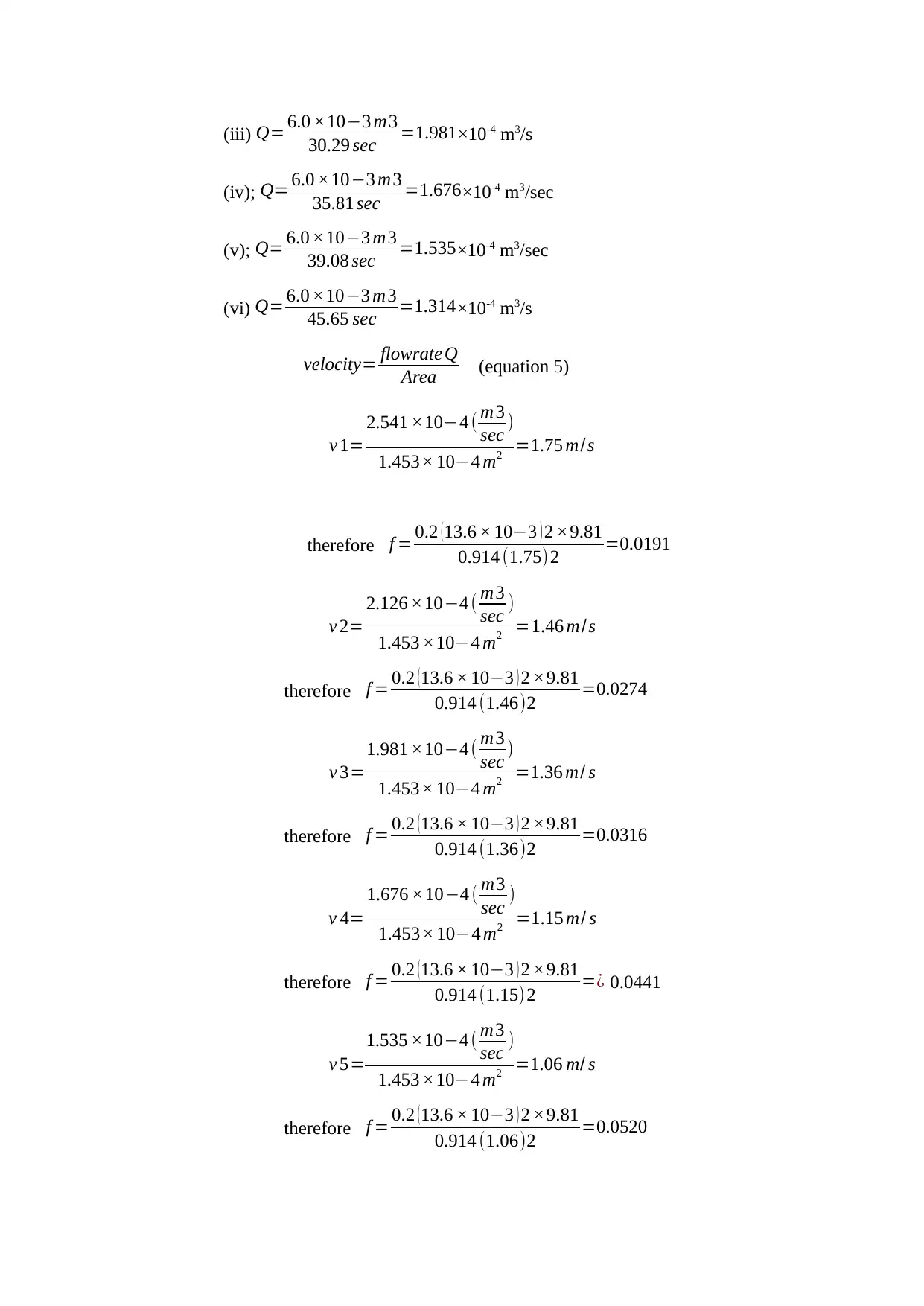
(iii) Q= 6.0 ×10−3 m3
30.29 sec =1.981×10-4 m3/s
(iv); Q= 6.0 ×10−3 m3
35.81 sec =1.676×10-4 m3/sec
(v); Q= 6.0 ×10−3 m3
39.08 sec =1.535×10-4 m3/sec
(vi) Q= 6.0 ×10−3 m3
45.65 sec =1.314×10-4 m3/s
velocity= flowrate Q
Area (equation 5)
v 1=
2.541 ×10−4 ( m3
sec )
1.453× 10−4 m2 =1.75 m/s
therefore f = 0.2 ( 13.6 × 10−3 ) 2 ×9.81
0.914 (1.75)2 =0.0191
v 2=
2.126 ×10−4 ( m3
sec )
1.453 ×10−4 m2 =1.46 m/s
therefore f = 0.2 ( 13.6 × 10−3 ) 2 ×9.81
0.914 (1.46)2 =0.0274
v 3=
1.981 ×10−4 ( m3
sec )
1.453× 10−4 m2 =1.36 m/ s
therefore f = 0.2 ( 13.6 × 10−3 ) 2 ×9.81
0.914 (1.36)2 =0.0316
v 4=
1.676 ×10−4 ( m3
sec )
1.453× 10−4 m2 =1.15 m/ s
therefore f = 0.2 ( 13.6 × 10−3 ) 2 ×9.81
0.914 (1.15) 2 =¿ 0.0441
v 5=
1.535 ×10−4 ( m3
sec )
1.453 ×10−4 m2 =1.06 m/ s
therefore f = 0.2 ( 13.6 × 10−3 ) 2 ×9.81
0.914 (1.06)2 =0.0520
30.29 sec =1.981×10-4 m3/s
(iv); Q= 6.0 ×10−3 m3
35.81 sec =1.676×10-4 m3/sec
(v); Q= 6.0 ×10−3 m3
39.08 sec =1.535×10-4 m3/sec
(vi) Q= 6.0 ×10−3 m3
45.65 sec =1.314×10-4 m3/s
velocity= flowrate Q
Area (equation 5)
v 1=
2.541 ×10−4 ( m3
sec )
1.453× 10−4 m2 =1.75 m/s
therefore f = 0.2 ( 13.6 × 10−3 ) 2 ×9.81
0.914 (1.75)2 =0.0191
v 2=
2.126 ×10−4 ( m3
sec )
1.453 ×10−4 m2 =1.46 m/s
therefore f = 0.2 ( 13.6 × 10−3 ) 2 ×9.81
0.914 (1.46)2 =0.0274
v 3=
1.981 ×10−4 ( m3
sec )
1.453× 10−4 m2 =1.36 m/ s
therefore f = 0.2 ( 13.6 × 10−3 ) 2 ×9.81
0.914 (1.36)2 =0.0316
v 4=
1.676 ×10−4 ( m3
sec )
1.453× 10−4 m2 =1.15 m/ s
therefore f = 0.2 ( 13.6 × 10−3 ) 2 ×9.81
0.914 (1.15) 2 =¿ 0.0441
v 5=
1.535 ×10−4 ( m3
sec )
1.453 ×10−4 m2 =1.06 m/ s
therefore f = 0.2 ( 13.6 × 10−3 ) 2 ×9.81
0.914 (1.06)2 =0.0520
⊘ This is a preview!⊘
Do you want full access?
Subscribe today to unlock all pages.

Trusted by 1+ million students worldwide
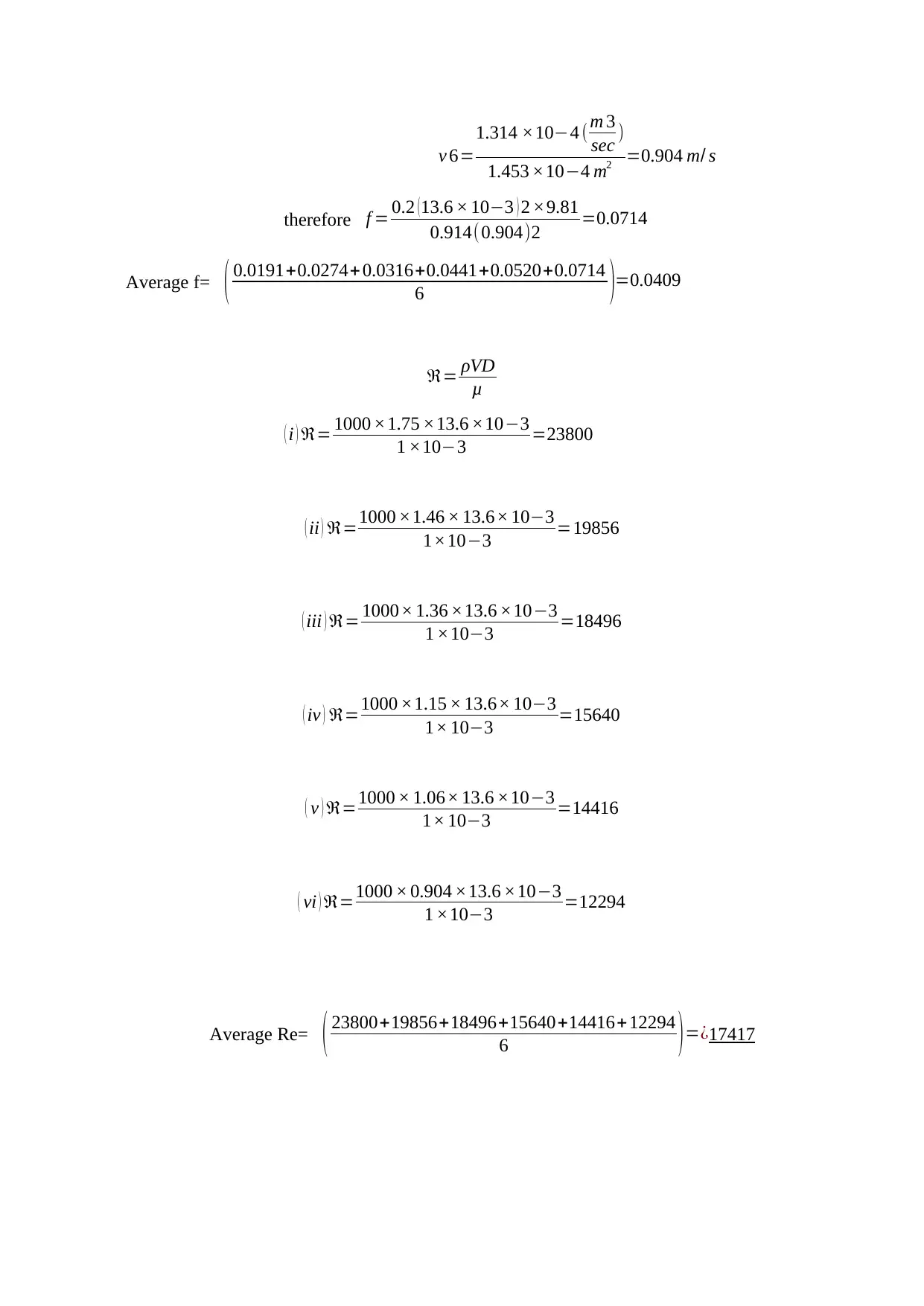
v 6=
1.314 ×10−4 (m 3
sec )
1.453 ×10−4 m2 =0.904 m/ s
therefore f = 0.2 (13.6 × 10−3 ) 2 ×9.81
0.914(0.904)2 =0.0714
Average f= ( 0.0191+0.0274+ 0.0316+0.0441+0.0520+0.0714
6 )=0.0409
ℜ= ρVD
μ
( i ) ℜ= 1000 ×1.75 ×13.6 ×10−3
1 ×10−3 =23800
( ii ) ℜ=1000 ×1.46 × 13.6× 10−3
1×10−3 =19856
( iii ) ℜ= 1000× 1.36 ×13.6 ×10−3
1 ×10−3 =18496
( iv ) ℜ=1000 ×1.15 × 13.6× 10−3
1× 10−3 =15640
( v ) ℜ=1000 × 1.06× 13.6 ×10−3
1× 10−3 =14416
( vi ) ℜ=1000 × 0.904 ×13.6 ×10−3
1 ×10−3 =12294
Average Re= ( 23800+19856+18496+15640+14416+12294
6 ) =¿17417
1.314 ×10−4 (m 3
sec )
1.453 ×10−4 m2 =0.904 m/ s
therefore f = 0.2 (13.6 × 10−3 ) 2 ×9.81
0.914(0.904)2 =0.0714
Average f= ( 0.0191+0.0274+ 0.0316+0.0441+0.0520+0.0714
6 )=0.0409
ℜ= ρVD
μ
( i ) ℜ= 1000 ×1.75 ×13.6 ×10−3
1 ×10−3 =23800
( ii ) ℜ=1000 ×1.46 × 13.6× 10−3
1×10−3 =19856
( iii ) ℜ= 1000× 1.36 ×13.6 ×10−3
1 ×10−3 =18496
( iv ) ℜ=1000 ×1.15 × 13.6× 10−3
1× 10−3 =15640
( v ) ℜ=1000 × 1.06× 13.6 ×10−3
1× 10−3 =14416
( vi ) ℜ=1000 × 0.904 ×13.6 ×10−3
1 ×10−3 =12294
Average Re= ( 23800+19856+18496+15640+14416+12294
6 ) =¿17417
Paraphrase This Document
Need a fresh take? Get an instant paraphrase of this document with our AI Paraphraser
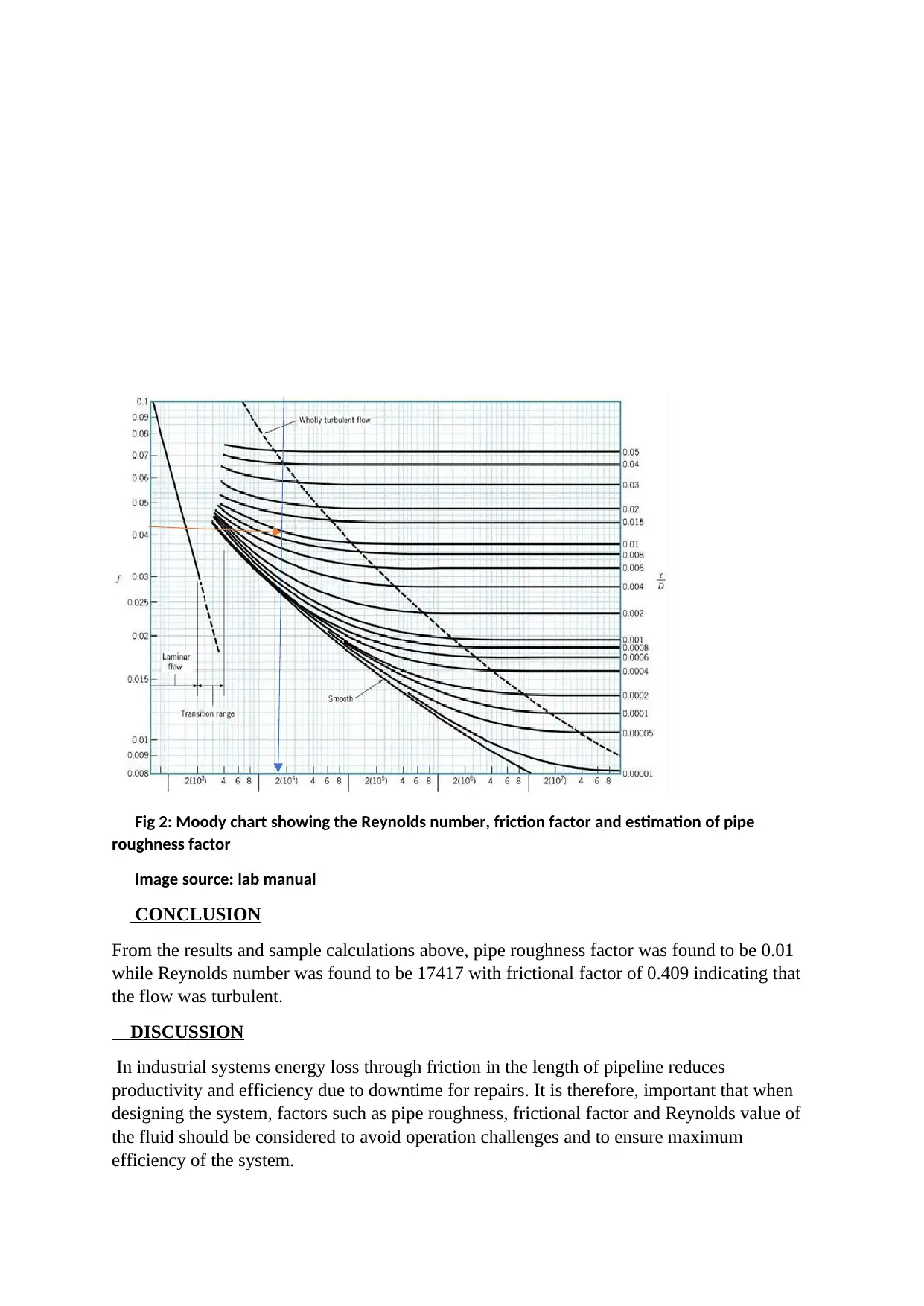
Fig 2: Moody chart showing the Reynolds number, friction factor and estimation of pipe
roughness factor
Image source: lab manual
CONCLUSION
From the results and sample calculations above, pipe roughness factor was found to be 0.01
while Reynolds number was found to be 17417 with frictional factor of 0.409 indicating that
the flow was turbulent.
DISCUSSION
In industrial systems energy loss through friction in the length of pipeline reduces
productivity and efficiency due to downtime for repairs. It is therefore, important that when
designing the system, factors such as pipe roughness, frictional factor and Reynolds value of
the fluid should be considered to avoid operation challenges and to ensure maximum
efficiency of the system.
roughness factor
Image source: lab manual
CONCLUSION
From the results and sample calculations above, pipe roughness factor was found to be 0.01
while Reynolds number was found to be 17417 with frictional factor of 0.409 indicating that
the flow was turbulent.
DISCUSSION
In industrial systems energy loss through friction in the length of pipeline reduces
productivity and efficiency due to downtime for repairs. It is therefore, important that when
designing the system, factors such as pipe roughness, frictional factor and Reynolds value of
the fluid should be considered to avoid operation challenges and to ensure maximum
efficiency of the system.
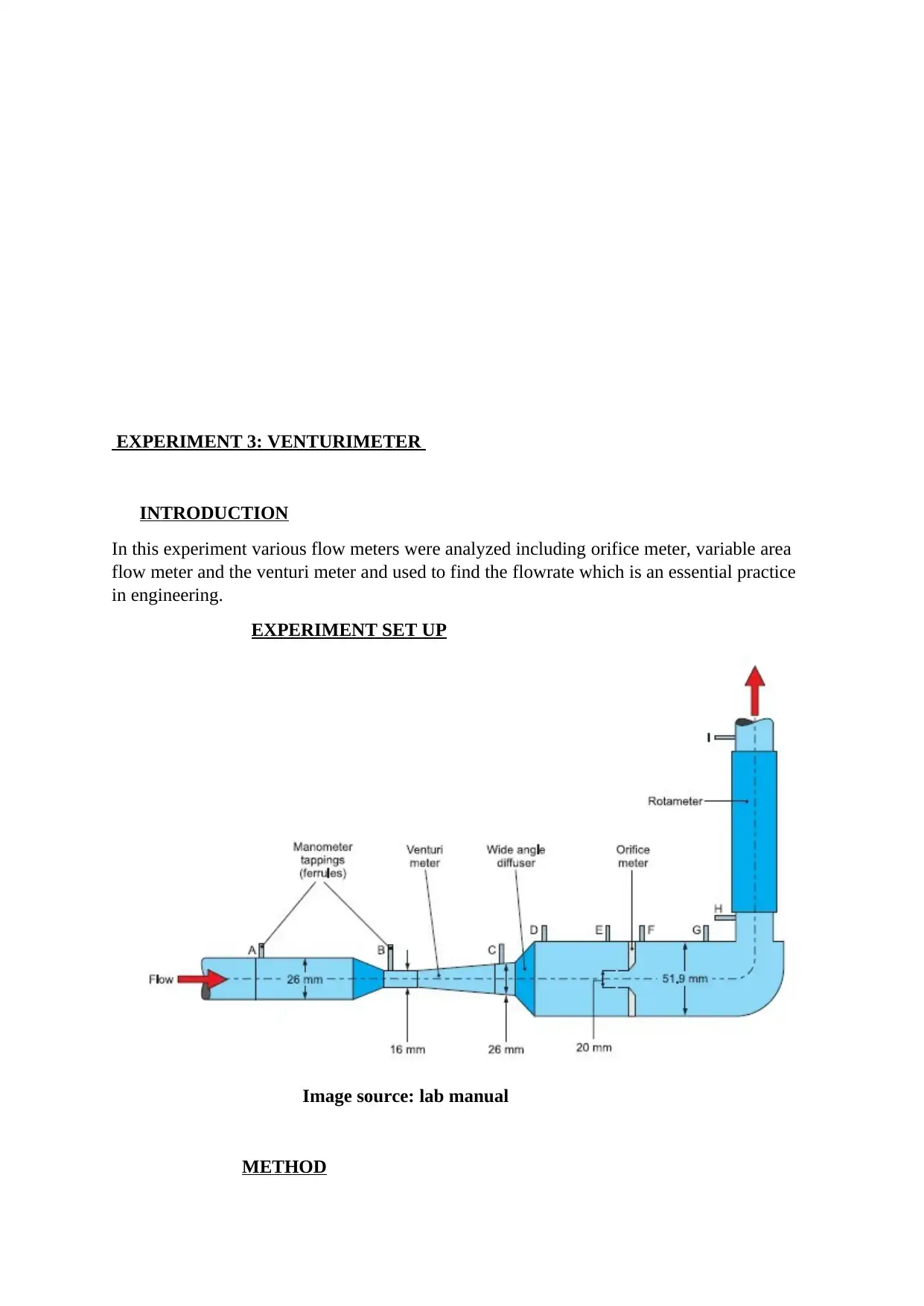
EXPERIMENT 3: VENTURIMETER
INTRODUCTION
In this experiment various flow meters were analyzed including orifice meter, variable area
flow meter and the venturi meter and used to find the flowrate which is an essential practice
in engineering.
EXPERIMENT SET UP
Image source: lab manual
METHOD
INTRODUCTION
In this experiment various flow meters were analyzed including orifice meter, variable area
flow meter and the venturi meter and used to find the flowrate which is an essential practice
in engineering.
EXPERIMENT SET UP
Image source: lab manual
METHOD
⊘ This is a preview!⊘
Do you want full access?
Subscribe today to unlock all pages.

Trusted by 1+ million students worldwide
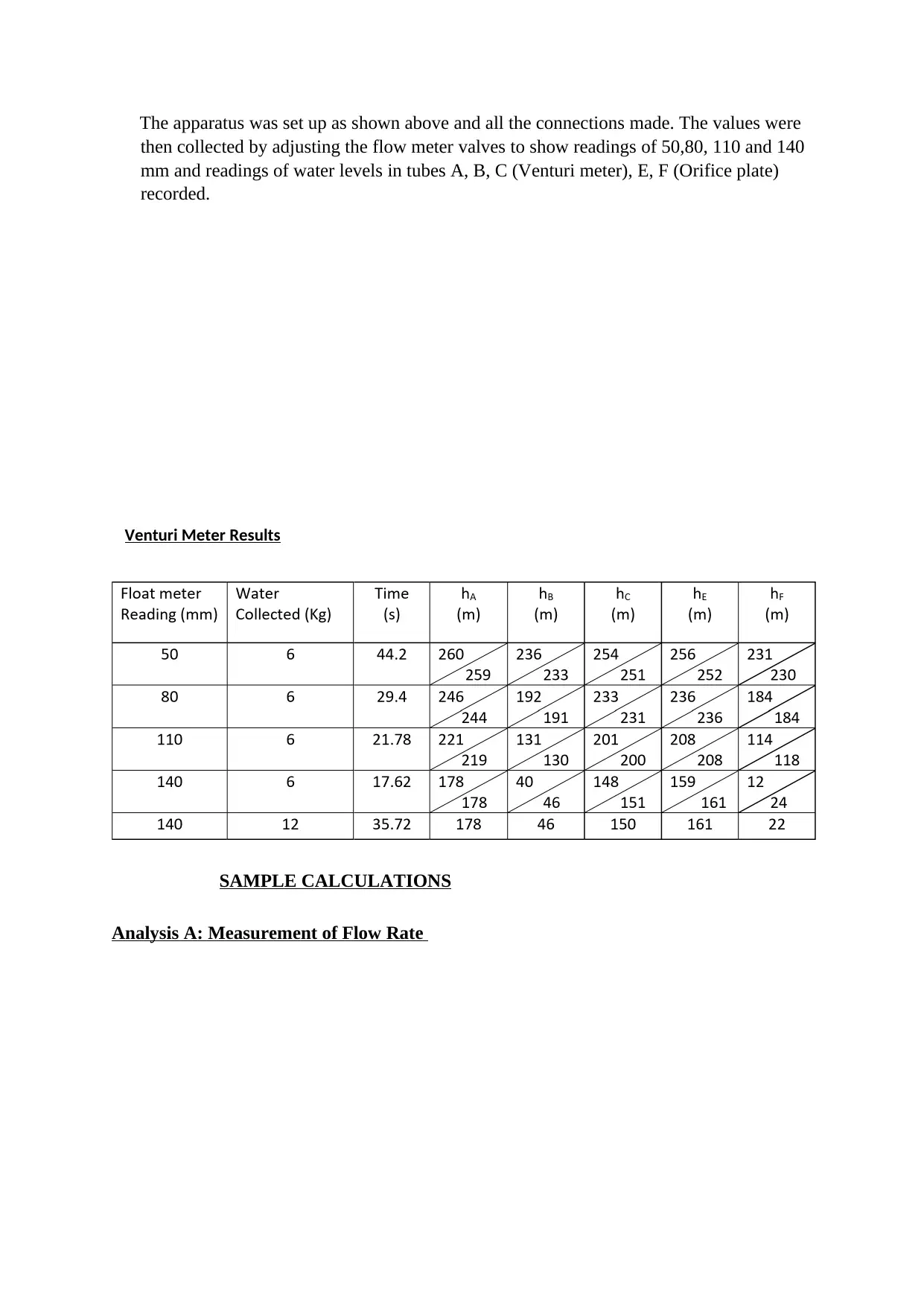
The apparatus was set up as shown above and all the connections made. The values were
then collected by adjusting the flow meter valves to show readings of 50,80, 110 and 140
mm and readings of water levels in tubes A, B, C (Venturi meter), E, F (Orifice plate)
recorded.
Venturi Meter Results
SAMPLE CALCULATIONS
Analysis A: Measurement of Flow Rate
then collected by adjusting the flow meter valves to show readings of 50,80, 110 and 140
mm and readings of water levels in tubes A, B, C (Venturi meter), E, F (Orifice plate)
recorded.
Venturi Meter Results
SAMPLE CALCULATIONS
Analysis A: Measurement of Flow Rate
Paraphrase This Document
Need a fresh take? Get an instant paraphrase of this document with our AI Paraphraser
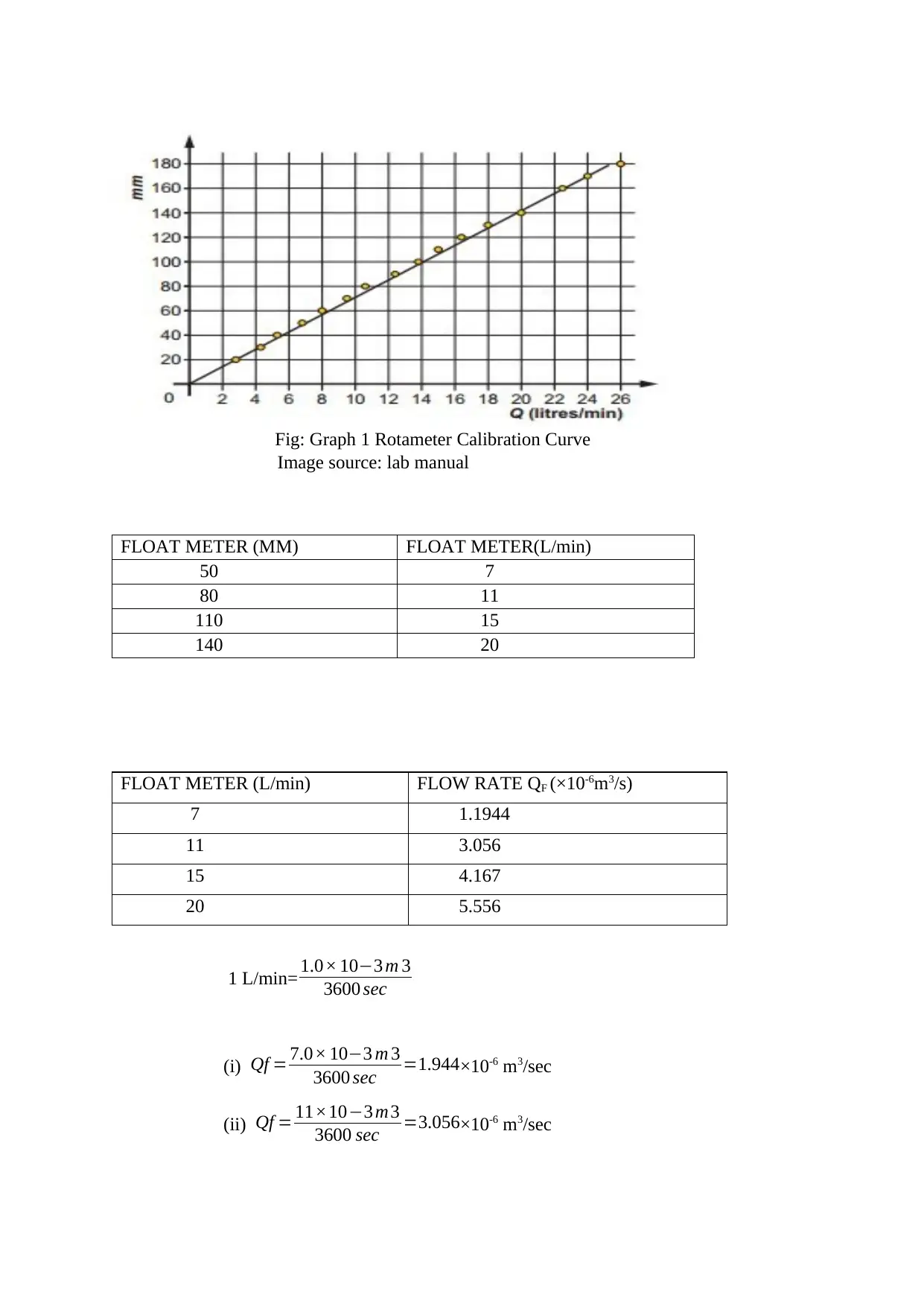
Fig: Graph 1 Rotameter Calibration Curve
Image source: lab manual
FLOAT METER (MM) FLOAT METER(L/min)
50 7
80 11
110 15
140 20
FLOAT METER (L/min) FLOW RATE QF (×10-6m3/s)
7 1.1944
11 3.056
15 4.167
20 5.556
1 L/min= 1.0× 10−3 m 3
3600 sec
(i) Qf = 7.0× 10−3 m 3
3600 sec =1.944×10-6 m3/sec
(ii) Qf = 11×10−3 m3
3600 sec =3.056×10-6 m3/sec
Image source: lab manual
FLOAT METER (MM) FLOAT METER(L/min)
50 7
80 11
110 15
140 20
FLOAT METER (L/min) FLOW RATE QF (×10-6m3/s)
7 1.1944
11 3.056
15 4.167
20 5.556
1 L/min= 1.0× 10−3 m 3
3600 sec
(i) Qf = 7.0× 10−3 m 3
3600 sec =1.944×10-6 m3/sec
(ii) Qf = 11×10−3 m3
3600 sec =3.056×10-6 m3/sec
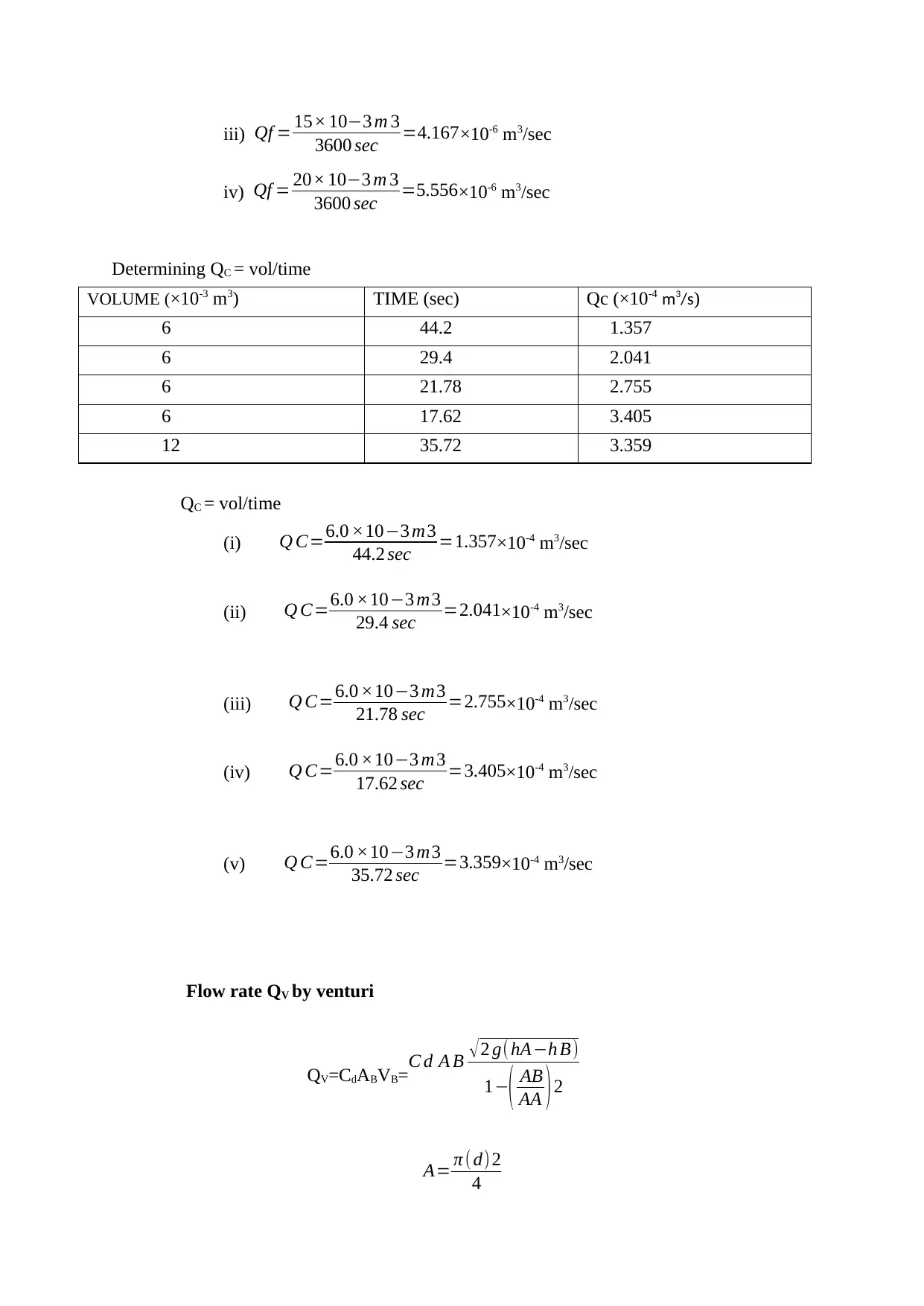
iii) Qf = 15× 10−3 m 3
3600 sec =4.167×10-6 m3/sec
iv) Qf = 20× 10−3 m 3
3600 sec =5.556×10-6 m3/sec
Determining QC = vol/time
VOLUME (×10-3 m3) TIME (sec) Qc (×10-4 m3/s)
6 44.2 1.357
6 29.4 2.041
6 21.78 2.755
6 17.62 3.405
12 35.72 3.359
QC = vol/time
(i) Q C=6.0 ×10−3 m3
44.2 sec =1.357×10-4 m3/sec
(ii) Q C=6.0 ×10−3 m3
29.4 sec =2.041×10-4 m3/sec
(iii) Q C=6.0 ×10−3 m3
21.78 sec =2.755×10-4 m3/sec
(iv) Q C=6.0 ×10−3 m3
17.62 sec =3.405×10-4 m3/sec
(v) Q C=6.0 ×10−3 m3
35.72 sec =3.359×10-4 m3/sec
Flow rate QV by venturi
QV=CdABVB=C d A B √2 g(hA−h B)
1−( AB
AA )2
A= π ( d) 2
4
3600 sec =4.167×10-6 m3/sec
iv) Qf = 20× 10−3 m 3
3600 sec =5.556×10-6 m3/sec
Determining QC = vol/time
VOLUME (×10-3 m3) TIME (sec) Qc (×10-4 m3/s)
6 44.2 1.357
6 29.4 2.041
6 21.78 2.755
6 17.62 3.405
12 35.72 3.359
QC = vol/time
(i) Q C=6.0 ×10−3 m3
44.2 sec =1.357×10-4 m3/sec
(ii) Q C=6.0 ×10−3 m3
29.4 sec =2.041×10-4 m3/sec
(iii) Q C=6.0 ×10−3 m3
21.78 sec =2.755×10-4 m3/sec
(iv) Q C=6.0 ×10−3 m3
17.62 sec =3.405×10-4 m3/sec
(v) Q C=6.0 ×10−3 m3
35.72 sec =3.359×10-4 m3/sec
Flow rate QV by venturi
QV=CdABVB=C d A B √2 g(hA−h B)
1−( AB
AA )2
A= π ( d) 2
4
⊘ This is a preview!⊘
Do you want full access?
Subscribe today to unlock all pages.

Trusted by 1+ million students worldwide
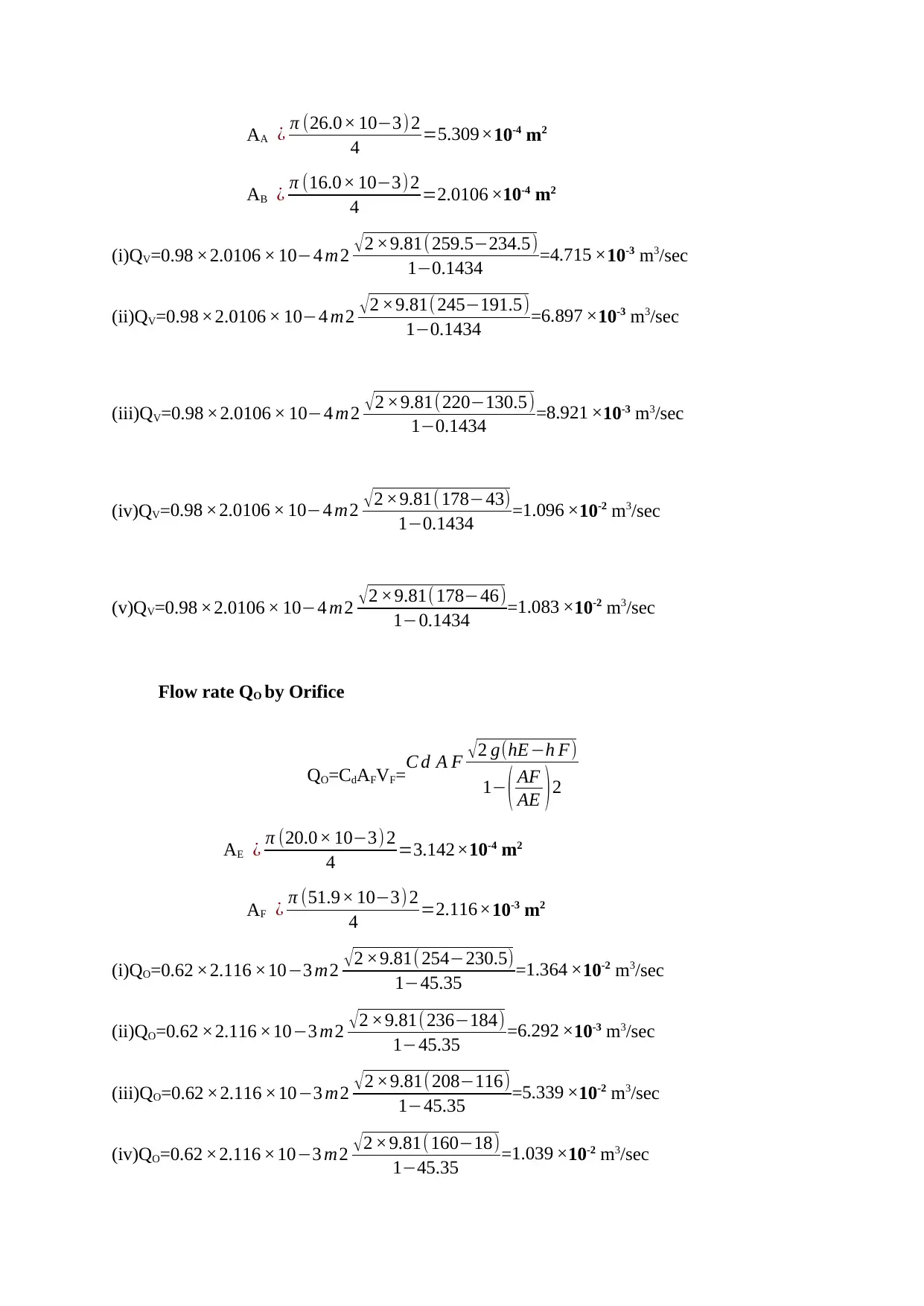
AA ¿ π (26.0× 10−3) 2
4 =5.309×10-4 m2
AB ¿ π (16.0× 10−3)2
4 =2.0106 ×10-4 m2
(i)QV=0.98 ×2.0106 × 10−4 m2 √ 2 ×9.81( 259.5−234.5)
1−0.1434 =4.715 ×10-3 m3/sec
(ii)QV=0.98 ×2.0106 × 10−4 m2 √ 2 ×9.81(245−191.5)
1−0.1434 =6.897 ×10-3 m3/sec
(iii)QV=0.98 ×2.0106 × 10−4 m2 √ 2 ×9.81(220−130.5)
1−0.1434 =8.921 ×10-3 m3/sec
(iv)QV=0.98 ×2.0106 × 10−4 m2 √2 ×9.81( 178−43)
1−0.1434 =1.096 ×10-2 m3/sec
(v)QV=0.98 ×2.0106 × 10−4 m2 √ 2 ×9.81(178−46)
1−0.1434 =1.083 ×10-2 m3/sec
Flow rate QO by Orifice
QO=CdAFVF=
C d A F √ 2 g(hE−h F)
1− ( AF
AE ) 2
AE ¿ π (20.0× 10−3) 2
4 =3.142×10-4 m2
AF ¿ π (51.9× 10−3) 2
4 =2.116×10-3 m2
(i)QO=0.62 ×2.116 ×10−3 m2 √2 ×9.81( 254−230.5)
1−45.35 =1.364 ×10-2 m3/sec
(ii)QO=0.62 ×2.116 ×10−3 m2 √2 ×9.81( 236−184)
1−45.35 =6.292 ×10-3 m3/sec
(iii)QO=0.62 ×2.116 ×10−3 m2 √ 2 ×9.81( 208−116)
1−45.35 =5.339 ×10-2 m3/sec
(iv)QO=0.62 ×2.116 ×10−3 m2 √2 ×9.81(160−18)
1−45.35 =1.039 ×10-2 m3/sec
4 =5.309×10-4 m2
AB ¿ π (16.0× 10−3)2
4 =2.0106 ×10-4 m2
(i)QV=0.98 ×2.0106 × 10−4 m2 √ 2 ×9.81( 259.5−234.5)
1−0.1434 =4.715 ×10-3 m3/sec
(ii)QV=0.98 ×2.0106 × 10−4 m2 √ 2 ×9.81(245−191.5)
1−0.1434 =6.897 ×10-3 m3/sec
(iii)QV=0.98 ×2.0106 × 10−4 m2 √ 2 ×9.81(220−130.5)
1−0.1434 =8.921 ×10-3 m3/sec
(iv)QV=0.98 ×2.0106 × 10−4 m2 √2 ×9.81( 178−43)
1−0.1434 =1.096 ×10-2 m3/sec
(v)QV=0.98 ×2.0106 × 10−4 m2 √ 2 ×9.81(178−46)
1−0.1434 =1.083 ×10-2 m3/sec
Flow rate QO by Orifice
QO=CdAFVF=
C d A F √ 2 g(hE−h F)
1− ( AF
AE ) 2
AE ¿ π (20.0× 10−3) 2
4 =3.142×10-4 m2
AF ¿ π (51.9× 10−3) 2
4 =2.116×10-3 m2
(i)QO=0.62 ×2.116 ×10−3 m2 √2 ×9.81( 254−230.5)
1−45.35 =1.364 ×10-2 m3/sec
(ii)QO=0.62 ×2.116 ×10−3 m2 √2 ×9.81( 236−184)
1−45.35 =6.292 ×10-3 m3/sec
(iii)QO=0.62 ×2.116 ×10−3 m2 √ 2 ×9.81( 208−116)
1−45.35 =5.339 ×10-2 m3/sec
(iv)QO=0.62 ×2.116 ×10−3 m2 √2 ×9.81(160−18)
1−45.35 =1.039 ×10-2 m3/sec
Paraphrase This Document
Need a fresh take? Get an instant paraphrase of this document with our AI Paraphraser
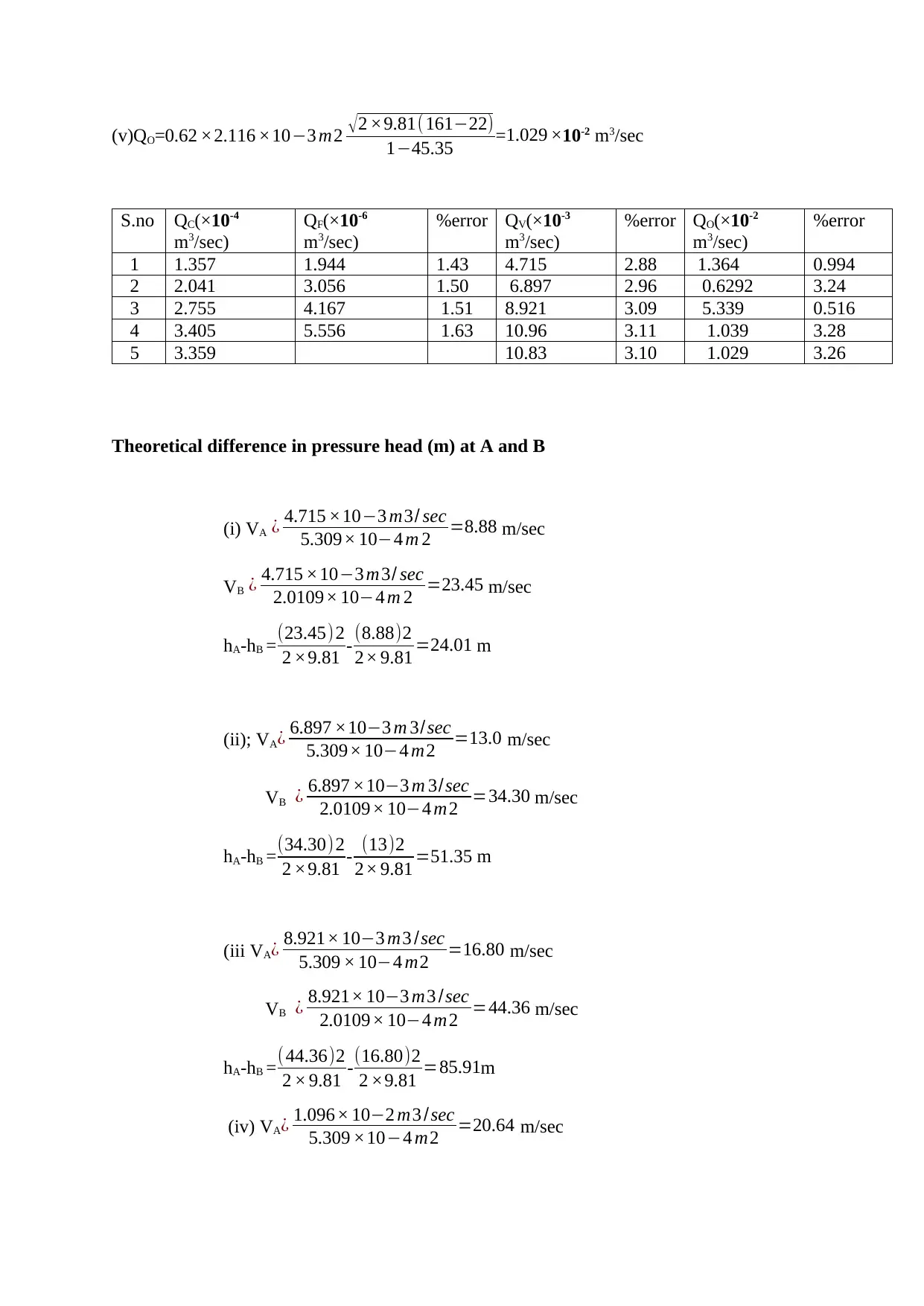
(v)QO=0.62 ×2.116 ×10−3 m2 √2 ×9.81( 161−22)
1−45.35 =1.029 ×10-2 m3/sec
S.no QC(×10-4
m3/sec)
QF(×10-6
m3/sec)
%error QV(×10-3
m3/sec)
%error QO(×10-2
m3/sec)
%error
1 1.357 1.944 1.43 4.715 2.88 1.364 0.994
2 2.041 3.056 1.50 6.897 2.96 0.6292 3.24
3 2.755 4.167 1.51 8.921 3.09 5.339 0.516
4 3.405 5.556 1.63 10.96 3.11 1.039 3.28
5 3.359 10.83 3.10 1.029 3.26
Theoretical difference in pressure head (m) at A and B
(i) VA ¿ 4.715 ×10−3 m3/ sec
5.309× 10−4 m 2 =8.88 m/sec
VB ¿ 4.715 ×10−3 m3/ sec
2.0109× 10−4 m 2 =23.45 m/sec
hA-hB = (23.45)2
2 ×9.81 - (8.88)2
2× 9.81 =24.01 m
(ii); VA¿ 6.897 ×10−3 m 3/sec
5.309× 10−4 m2 =13.0 m/sec
VB ¿ 6.897 ×10−3 m 3/sec
2.0109× 10−4 m2 =34.30 m/sec
hA-hB = (34.30)2
2 ×9.81 - (13)2
2× 9.81 =51.35 m
(iii VA¿ 8.921× 10−3 m3 /sec
5.309 × 10−4 m2 =16.80 m/sec
VB ¿ 8.921× 10−3 m3 /sec
2.0109× 10−4 m2 =44.36 m/sec
hA-hB =(44.36)2
2 × 9.81 -(16.80)2
2 ×9.81 =85.91m
(iv) VA¿ 1.096× 10−2 m3 /sec
5.309 ×10−4 m2 =20.64 m/sec
1−45.35 =1.029 ×10-2 m3/sec
S.no QC(×10-4
m3/sec)
QF(×10-6
m3/sec)
%error QV(×10-3
m3/sec)
%error QO(×10-2
m3/sec)
%error
1 1.357 1.944 1.43 4.715 2.88 1.364 0.994
2 2.041 3.056 1.50 6.897 2.96 0.6292 3.24
3 2.755 4.167 1.51 8.921 3.09 5.339 0.516
4 3.405 5.556 1.63 10.96 3.11 1.039 3.28
5 3.359 10.83 3.10 1.029 3.26
Theoretical difference in pressure head (m) at A and B
(i) VA ¿ 4.715 ×10−3 m3/ sec
5.309× 10−4 m 2 =8.88 m/sec
VB ¿ 4.715 ×10−3 m3/ sec
2.0109× 10−4 m 2 =23.45 m/sec
hA-hB = (23.45)2
2 ×9.81 - (8.88)2
2× 9.81 =24.01 m
(ii); VA¿ 6.897 ×10−3 m 3/sec
5.309× 10−4 m2 =13.0 m/sec
VB ¿ 6.897 ×10−3 m 3/sec
2.0109× 10−4 m2 =34.30 m/sec
hA-hB = (34.30)2
2 ×9.81 - (13)2
2× 9.81 =51.35 m
(iii VA¿ 8.921× 10−3 m3 /sec
5.309 × 10−4 m2 =16.80 m/sec
VB ¿ 8.921× 10−3 m3 /sec
2.0109× 10−4 m2 =44.36 m/sec
hA-hB =(44.36)2
2 × 9.81 -(16.80)2
2 ×9.81 =85.91m
(iv) VA¿ 1.096× 10−2 m3 /sec
5.309 ×10−4 m2 =20.64 m/sec
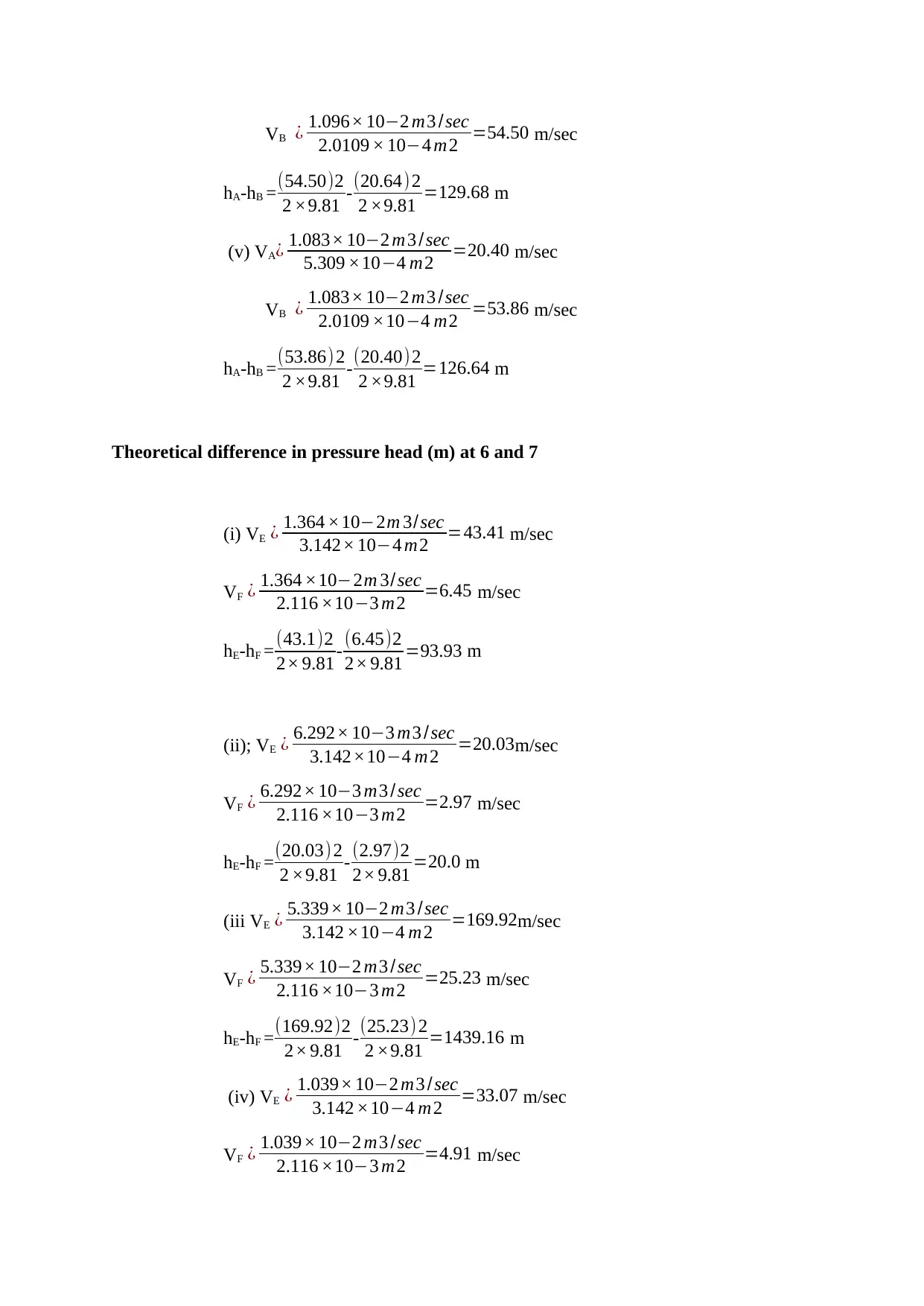
VB ¿ 1.096× 10−2 m3 /sec
2.0109 × 10−4 m2 =54.50 m/sec
hA-hB =(54.50)2
2 ×9.81 -(20.64)2
2 ×9.81 =129.68 m
(v) VA¿ 1.083× 10−2 m3 / sec
5.309 ×10−4 m2 =20.40 m/sec
VB ¿ 1.083× 10−2 m3 /sec
2.0109 ×10−4 m2 =53.86 m/sec
hA-hB =(53.86) 2
2 ×9.81 -(20.40)2
2 ×9.81 =126.64 m
Theoretical difference in pressure head (m) at 6 and 7
(i) VE ¿ 1.364 ×10−2m 3/sec
3.142× 10−4 m2 =43.41 m/sec
VF ¿ 1.364 ×10−2m 3/ sec
2.116 ×10−3 m2 =6.45 m/sec
hE-hF = (43.1)2
2× 9.81- (6.45)2
2× 9.81 =93.93 m
(ii); VE ¿ 6.292× 10−3 m3 /sec
3.142×10−4 m2 =20.03m/sec
VF ¿ 6.292× 10−3 m3 / sec
2.116 ×10−3 m2 =2.97 m/sec
hE-hF =(20.03)2
2 ×9.81 - (2.97)2
2× 9.81 =20.0 m
(iii VE ¿ 5.339× 10−2 m3 /sec
3.142 ×10−4 m2 =169.92m/sec
VF ¿ 5.339× 10−2 m3 / sec
2.116 ×10−3 m2 =25.23 m/sec
hE-hF =(169.92)2
2× 9.81 - (25.23) 2
2 ×9.81 =1439.16 m
(iv) VE ¿ 1.039× 10−2 m3 /sec
3.142 ×10−4 m2 =33.07 m/sec
VF ¿ 1.039× 10−2 m3 /sec
2.116 ×10−3 m2 =4.91 m/sec
2.0109 × 10−4 m2 =54.50 m/sec
hA-hB =(54.50)2
2 ×9.81 -(20.64)2
2 ×9.81 =129.68 m
(v) VA¿ 1.083× 10−2 m3 / sec
5.309 ×10−4 m2 =20.40 m/sec
VB ¿ 1.083× 10−2 m3 /sec
2.0109 ×10−4 m2 =53.86 m/sec
hA-hB =(53.86) 2
2 ×9.81 -(20.40)2
2 ×9.81 =126.64 m
Theoretical difference in pressure head (m) at 6 and 7
(i) VE ¿ 1.364 ×10−2m 3/sec
3.142× 10−4 m2 =43.41 m/sec
VF ¿ 1.364 ×10−2m 3/ sec
2.116 ×10−3 m2 =6.45 m/sec
hE-hF = (43.1)2
2× 9.81- (6.45)2
2× 9.81 =93.93 m
(ii); VE ¿ 6.292× 10−3 m3 /sec
3.142×10−4 m2 =20.03m/sec
VF ¿ 6.292× 10−3 m3 / sec
2.116 ×10−3 m2 =2.97 m/sec
hE-hF =(20.03)2
2 ×9.81 - (2.97)2
2× 9.81 =20.0 m
(iii VE ¿ 5.339× 10−2 m3 /sec
3.142 ×10−4 m2 =169.92m/sec
VF ¿ 5.339× 10−2 m3 / sec
2.116 ×10−3 m2 =25.23 m/sec
hE-hF =(169.92)2
2× 9.81 - (25.23) 2
2 ×9.81 =1439.16 m
(iv) VE ¿ 1.039× 10−2 m3 /sec
3.142 ×10−4 m2 =33.07 m/sec
VF ¿ 1.039× 10−2 m3 /sec
2.116 ×10−3 m2 =4.91 m/sec
⊘ This is a preview!⊘
Do you want full access?
Subscribe today to unlock all pages.

Trusted by 1+ million students worldwide
1 out of 20
Your All-in-One AI-Powered Toolkit for Academic Success.
+13062052269
info@desklib.com
Available 24*7 on WhatsApp / Email
![[object Object]](/_next/static/media/star-bottom.7253800d.svg)
Unlock your academic potential
Copyright © 2020–2025 A2Z Services. All Rights Reserved. Developed and managed by ZUCOL.
